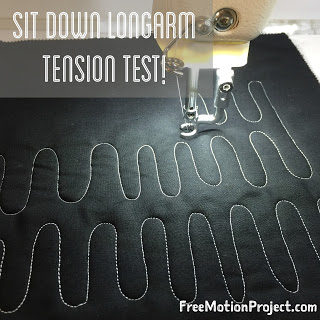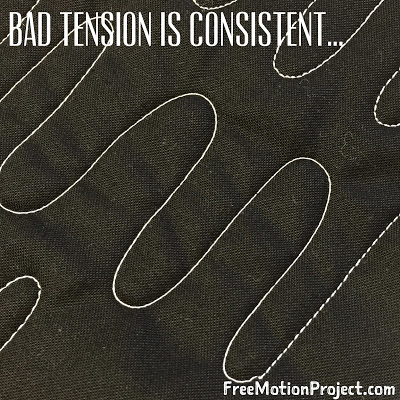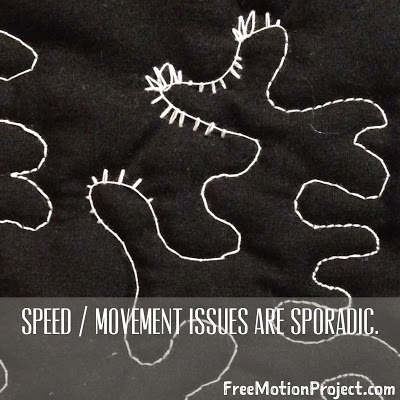Quilting Tension Test! Sit Down Quilting Sunday #2
The most common question I received was about adjusting your tension so in this week’s video let’s learn how to do a tension test:
 Click Here to read more about the Grace Qnique.
Click Here to read more about the Grace Qnique.
Apparently in forums and reviews, tension issues were the most common complaint about the Grace Qnique. All I can speak for is my personal experience and I’ve found the tension to be very easy to set on this machine.
So far I haven’t experienced any tension or stitching issues that were not caused by something going wrong in the threading of the machine – either I missed a guide while threading the machine or the thread hopped out of a guide while quilting.
With a home machine, you might be able to miss a guide and it won’t totally mess up your tension. I don’t think that holds for longarm quilting machines. Every guide must be threaded exactly or the top and bobbin threads will not be balanced.
Another thing to consider is the speed of the machine. Longarm quilting machines stitch very fast and it’s easy to confuse a speed / movement issue with a tension issue.
Here’s the difference – a tension issue will show up consistently no matter what design, shape, or direction you are quilting. I’ve adjusted the tension here to pull too tight to the top and you can see the white bobbin thread pulling to the top of the quilt with every stitch.

A speed / movement issue will have weird fluctuations only in specific spots like a certain curve. This happens when the movement of your hands doesn’t work with the speed of the machine and the thread pulls in this weird way. We call this eyelashes:

See how the eyelashes only pull in certain curves? See how the thread is mostly balanced at other times? That’s speed / movement issues, not tension.
These issues will also not go away no matter how much you adjust your tension dial because the tension has nothing to do with it. It’s the movement of your hands that’s the culprit here. You need to slow down your hands and work to get in time with the speed of the machine.
Foot Height and Stitch Quality
Another thing that can effect the look of your stitches is the height of your quilting foot. If the foot is set too high, it can allow the quilt to bounce a bit as you stitch over it.
This can cause the stitches to look very slightly unbalanced, and it’s usually inconsistent. I’ve found that when my foot is too high and I quilt backwards, the stitches will pull slightly to the top of the quilt. This is subtle, but if you’re paying very close attention to your quilting, it may appear as another annoying tension fluctuation.
But it’s an easy fix – whenever you switch from one quilt to another, unscrew your presser foot slightly and drop your needle in the down position. You want the foot to make contact with the top of the quilt, but not squish it. Also make sure to wiggle the foot around until the needle is positioned right in the center of the circular base and tighten up the screw.
Check Your Tension Often
How can you guarantee your stitches will look great on every quilt you make? Do this tension test daily! Every time you start a new project, every time you change thread types, and every time you’re quilting with a different batting because all of these things can effect your quilting stitches and the tension balance.
If you begin each quilting session with a small tension test, you’re going to have a better experience all around. Your body will be more warmed up for free motion quilting, you’ll sort out any ugly stitch issues on a scrap sandwich rather than your real quilt, and you can adjust the tension so it’s perfectly balanced as you start your project.
Many times I’ve heard quilters complain about checking tension as a waste of time and thread. Since when did thread become such a valuable, limited resource? Spend it out and you will SAVE time not having to rip out stitches because you didn’t check your tension and stitch quality to start.
Now that I’ve answered the most frequent question about the Grace Qnique, what’s your next question? What would you like to see next in this series? Please share your ideas and questions in the comments below!
Let’s go quilt,
Leah Day

Thanks Leah you always have such good advice for those of us who only use a home machine to FAQ on.
Great job on your explanation and demonstration of tension and speed. I look forward to more Sit Down Sundays.
I'm so glad you are doing these videos. Looking forward to next one.
Thanks Leah…… your explanations answered all my questions….. thanks so much!!!
Leah, you teach beautifully! Thorough, detailed, and fun. One of my concerns has been that mid-arms hop. You'd indicated there is a way to adjust the amount or force of hop or something like that. Can you share how to do that and how it changes the way you quilt from a DSM? And does this machine have more than one foot? Know the APQS George and Handiquilter Sweet Sixteen do, but those machines are DOUBLE the price of the Q'Nique and I'm not at those price ranges.
Great questions Julie! On hopping – there's no way to stop it completely, but by lowering the foot as low as you can (without it hammering into the top of the machine) it will limit how much the foot moves. There will be more feet available on this machine soon. We're just getting the final details on that and I'll be able to share a video on what each foot does and how they work.
I rarely do free motion quilting since I installed the QCT. The speed of my machine is set on slowest, the stitch length is 10 spi and on a lot of curves I get eyelashes. Since I know this is speed and not tension, how can I prevent the eyelashes? Should I shorten the stitch length?
Yes, I’d shorten the stitch length. I like 15 stitches per inch with QCT. I’d also play with different types of thread and also check your bobbin tension. If the eyelashes are showing up on the top, you may need to tighten your bobbin tension a bit.